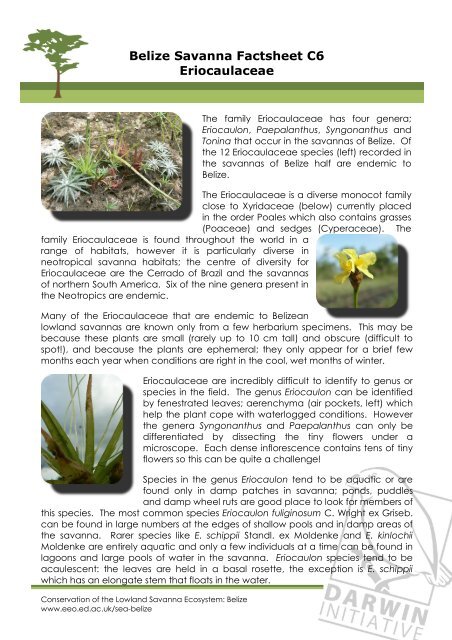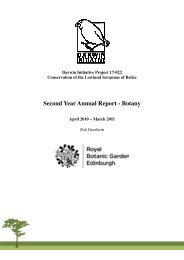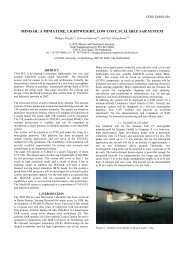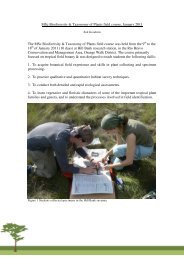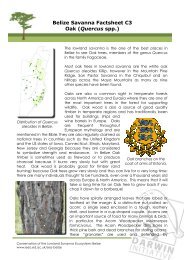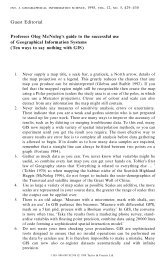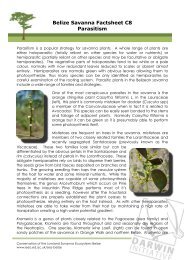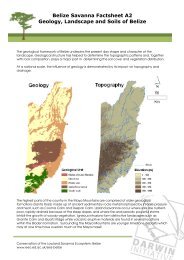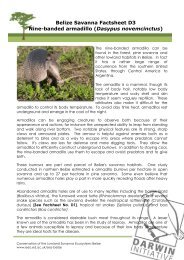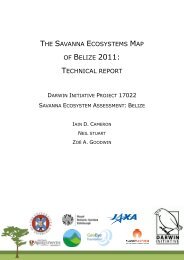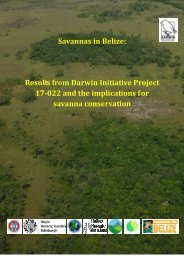Belize Savanna Factsheet C6 Eriocaulaceae
Belize Savanna Factsheet C6 Eriocaulaceae
Belize Savanna Factsheet C6 Eriocaulaceae
Create successful ePaper yourself
Turn your PDF publications into a flip-book with our unique Google optimized e-Paper software.
<strong>Belize</strong> <strong>Savanna</strong> <strong>Factsheet</strong> <strong>C6</strong><br />
<strong>Eriocaulaceae</strong><br />
Conservation of the Lowland <strong>Savanna</strong> Ecosystem: <strong>Belize</strong><br />
www.eeo.ed.ac.uk/sea-belize<br />
The family <strong>Eriocaulaceae</strong> has four genera;<br />
Eriocaulon, Paepalanthus, Syngonanthus and<br />
Tonina that occur in the savannas of <strong>Belize</strong>. Of<br />
the 12 <strong>Eriocaulaceae</strong> species (left) recorded in<br />
the savannas of <strong>Belize</strong> half are endemic to<br />
<strong>Belize</strong>.<br />
The <strong>Eriocaulaceae</strong> is a diverse monocot family<br />
close to Xyridaceae (below) currently placed<br />
in the order Poales which also contains grasses<br />
(Poaceae) and sedges (Cyperaceae). The<br />
family <strong>Eriocaulaceae</strong> is found throughout the world in a<br />
range of habitats, however it is particularly diverse in<br />
neotropical savanna habitats; the centre of diversity for<br />
<strong>Eriocaulaceae</strong> are the Cerrado of Brazil and the savannas<br />
of northern South America. Six of the nine genera present in<br />
the Neotropics are endemic.<br />
Many of the <strong>Eriocaulaceae</strong> that are endemic to <strong>Belize</strong>an<br />
lowland savannas are known only from a few herbarium specimens. This may be<br />
because these plants are small (rarely up to 10 cm tall) and obscure (difficult to<br />
spot!), and because the plants are ephemeral; they only appear for a brief few<br />
months each year when conditions are right in the cool, wet months of winter.<br />
<strong>Eriocaulaceae</strong> are incredibly difficult to identify to genus or<br />
species in the field. The genus Eriocaulon can be identified<br />
by fenestrated leaves; aerenchyma (air pockets, left) which<br />
help the plant cope with waterlogged conditions. However<br />
the genera Syngonanthus and Paepalanthus can only be<br />
differentiated by dissecting the tiny flowers under a<br />
microscope. Each dense inflorescence contains tens of tiny<br />
flowers so this can be quite a challenge!<br />
Species in the genus Eriocaulon tend to be aquatic or are<br />
found only in damp patches in savanna; ponds, puddles<br />
and damp wheel ruts are good place to look for members of<br />
this species. The most common species Eriocaulon fuliginosum C. Wright ex Griseb.<br />
can be found in large numbers at the edges of shallow pools and in damp areas of<br />
the savanna. Rarer species like E. schippii Standl. ex Moldenke and E. kinlochii<br />
Moldenke are entirely aquatic and only a few individuals at a time can be found in<br />
lagoons and large pools of water in the savanna. Eriocaulon species tend to be<br />
acaulescent: the leaves are held in a basal rosette, the exception is E. schippii<br />
which has an elongate stem that floats in the water.
References:<br />
Species in the genera Syngonanthus<br />
and Paepalanthus tend to be found<br />
in well-drained sandy areas of<br />
savanna, often under Pine or Oak<br />
trees. The most common species is<br />
Paepalanthus lamarckii Kunth, this<br />
species has an elongate stem (it is not<br />
acaulescent) with long hairs on the<br />
flat leaves and on the flower stalk<br />
(peduncle). The only species this<br />
might be confused with is the<br />
endemic species P. gentlei Moldenke; P. gentlei has broader<br />
leaves, no long hairs on the stem and leaves and a<br />
distinctive elongate inflorescence (above left), all the other<br />
<strong>Eriocaulaceae</strong> species have spherical inflorescences (above<br />
right). The other five species of Syngonanthus and<br />
Paepalanthus are acaulescent (left) and tend to be very<br />
small.<br />
Tonina is an aquatic herb with an elongated stem similar to<br />
E. schippii, however it uniquely has inflorescences arranged<br />
along the stem; all other <strong>Eriocaulaceae</strong> have their<br />
inflorescences held terminally, at the end of the stem.<br />
Angiosperm Phylogeny Group III (2009). An update of the Angiosperm Phylogeny Group<br />
classification for the orders and families of flowering plants: APG III. Botanical Journal of the Linnean<br />
Society 161: 105–121.<br />
Balick, M.J., Nee, M.H. & Atha, D.E. (2000). Checklist of the Vascular Plants of <strong>Belize</strong>. Memoirs of the<br />
New York Botanical Garden 85: 1–246.<br />
Davidse, G., Sousa Sánchez, M. & Chater, A.O. (1994). Alismataceae a Cyperaceae. In: Fl.<br />
Mesoamer. pp. 1–543. México: Universidad Nacional Autónoma de México<br />
Goodwin, Z.A., Harris, D.J., Bridgewater, S.G.M., Lopez, G.N., Haston, E., Cameron, I.D., Michelakis, D.,<br />
Ratter, J.A., Furley, P.A., Kay, E., Whitefoord, C., Solomon, J. & Stuart, N. (In Press). A checklist of the<br />
vascular plants of the lowland savannas and associated wetlands of <strong>Belize</strong>, Central America.<br />
Phytotaxa.<br />
Sano, P.T., Trovó, M. & Giulietti, A.M. (2011). Neotropical <strong>Eriocaulaceae</strong>, Neotropikey. In: Neotropikey.<br />
Board of Trustees of the Royal Botanic Gardens, Kew.<br />
Conservation of the Lowland <strong>Savanna</strong> Ecosystem: <strong>Belize</strong><br />
www.eeo.ed.ac.uk/sea-belize


